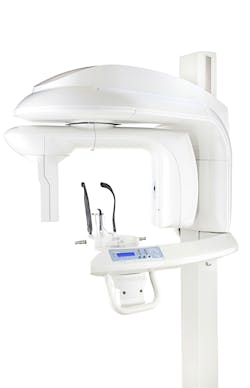Product spotlight: CS 9300 takes the guesswork out of examinations
Editor's note: This article is a part of Dental Economics' "Focus on Digital Dentistry," a social media feature for the month of October. Join the conversation on DE's facebook page or send us a tweet @dentalmagazine. #DEdigitalmonth
Over the past few years, 3D imaging has become an important tool to the modern dental practice. 3D imaging systems provide enhanced images that allow practitioners to uncover critical information that cannot be detected when relying solely upon 2D imaging. In addition to improved diagnoses and treatment planning, practitioners who have taken advantage of 3D imaging systems have discovered an improvement in doctor-patient communication, as patients are more likely to comprehend their diagnosis when the clinician can point out the problem on a more realistic 3D image rather than a static 2D image; ultimately resulting in increased case acceptance.
Today, insightful practitioners are implementing systems that give them the flexibility of both cone beam computed tomography (CBCT) and 2D imaging. The CS 9300 combines 3D technology with industry-leading panoramic imaging, and an optional one-shot cephalometric module to offer unprecedented diagnostic capabilities. The unit produces precise images in every modality enabling the user to see any anatomical examination from every angle with 1:1 accuracy. The CS 9300 features 3D imaging with up to seven selectable fields of view, ranging from 5 cm x 5 cm to 17 cm x 13.5 cm.
Most important, the CS 9300 gives practitioners more control in limiting radiation exposure to patients. Adhering to the “As Low As Reasonably Achievable” (ALARA) principle, Low Dose mode delivers a significantly lower radiation dose than standard CBCT programs in both configurations of the CS 9300 units. In fact, it allows for 3D imaging at a lower dose than panoramic imaging. The newest technological advances in software algorithms and noise reduction processing allow the units to capture effective low-dose 3D images. Additionally, the ability to focus on a specific region of interest limits radiation to only the relevant anatomical structure(s). Low Dose also reduces the overall length of exposure, capturing images in as little as 13 seconds. Low Dose mode is available for all 3D programs, and existing units can be retrofitted with the Low Dose module. In addition to low-dose 3D, the CS 9300 also lets you keep the flexibility of incredible quality 2D panoramic and one-shot cephalometric images when desired.
The CS 9300 also allows the user to collimate the imaging area—based on clinical needs—to further reduce radiation exposure. The unit is equipped with preview image “scout” technology, allowing users to evaluate patient positioning before 3D acquisition. This combination of speed, image quality and precision placement dramatically reduces the need for retakes. Optional cephalometric modality features “one-shot” technology that captures images in less than a second, reducing exposure time and the risk of retakes.
Despite the recognized clinical benefits of 3D imaging, some practitioners are reluctant to implement a 3D system in their practice out of concern for a presumed learning curve; dental professionals seek effective and intuitive tools that make their workflow easier, not overly-complicated. In response to these concerns, Carestream Dental’s 3D Imaging software can be integrated with leading imaging programs such as NobelGuide™, Simplant® and SureSmile®. Users can examine images in stunning detail, slice-by-slice in axial, coronal, sagittal, cross-sectional and oblique views for enhanced diagnostic interpretation. CS 3D Imaging includes a sophisticated implant planning feature that comes with pre-loaded libraries from implant manufacturers, as well as allows practitioners to create their own custom implant sizes.
Ultimately, 3D images deliver the most accurate view of patients’ anatomy for improved diagnostic treatment planning. The CS 9300 is an excellent way for professionals to integrate CBCT technology into their practices, as it offers the most extensive capabilities in one system and enables better communication between dentists and patients. This modern 3D technology impacts not only the initial diagnoses of patients but also their continual review and treatment, boosting the diagnostic confidence of the practitioner as well as the patient’s confidence in their dentist.
Editor's Note: To learn more about the CS 9300, as well as Carestream Dental’s other CBCT systems, please call (800) 944.6365 or visit carestreamdental.com.
Amanda Gong is the public relations manger for Carestream Dental and has been writing on a technical level for five years. She works to ensure that Carestream Dental's equipment is represented accurately in the media and builds relationships with industry magazines by providing resources, educational content, and general dental information for use in aritcles.
Related: Catherine's Story
Related: From concept to practice: The story of the CS 8100 3D
Related: CBCT scan verifies palatal root fracture prior to proposed sinus lift
